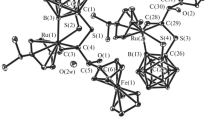Abstract
Deuterated dinuclear ruthenium(II,III) 3,4,5-tri(ethoxy-d 5)benzoate, [Ru2{3,4,5-(C2D5O)3C6H2-COO}4Cl] n , was synthesized by a reaction of [Ru2(C2H5COO)4Cl] n and 3,4,5-tri(ethoxy-d 5)benzoic acid and characterized by single-crystal X-ray analysis as well as IR, UV-VIS, and 1H NMR spectra, and compared with those of the undeuterated complex [Ru2{3,4,5-(C2H5O)3C6H2COO}4Cl] n . Single-crystal X-ray analysis showed that chloride ligands bridge the dinuclear ruthenium(II,III) units at the axial positions to form a zigzag chain molecule with the Ru1-Cl-Ru2 angle of 123.82(4)°. 1H NMR spectra in CD2Cl2 displayed a broad signal attributable to o-H atoms on the phenyl rings of the benzoate ligands from approximately δ = 23 to δ = 32 at 25°C and several signals from approximately δ = −50 to δ = 50 at −80°C. These spectra show the preservation of the polymeric or oligomeric chain structure in dichloromethane, which is supported by the solution behavior confirmed by the UV-VIS spectra and electronic conductance.
Similar content being viewed by others
References
Abe, M., Sakaki, Y., Yamaguchi, T., & Ito, T. (1992). X-ray structure, ligand substitution, and other properties of trinuclear ruthenium complex, [Ru3(μ 3-O)(μ-C6H5COO)6(py)3] (PF6) (py = pyridine), and X-ray structure of dinuclear ruthenium complex, [Ru2(μ-C6H5COO)4Cl]. Bulletin of the Chemical Society of Japan, 65, 1585–1590. DOI: 10.1246/bcsj.65.1585.
Angaridis, P. (2005). Ruthenium compounds. In F. A. Cotton, C. A. Murillo, & R. A. Walton (Eds.), Multiple bonds between metal atoms (pp. 377–430). New York, NY, USA: Springer. DOI: 10.1007/b136230.
Aquino, M. A. S. (2004). Recent developments in the synthesis and properties of diruthenium tetracarboxylates. Coordination Chemistry Reviews, 248, 1025–1045. DOI: 10.1016/j.ccr.2004.06.016.
Aquino, M. A. S. (1998). Diruthenium and diosmium tetracarboxylates: synthesis, physical properties and applications. Coordination Chemistry Reviews, 170, 141–202. DOI: 10. 1016/S0010-8545(97)00079-9.
Barral, M. C., González-Prieto, R., Herrero, S., Jiménez-Aparicio, R., Priego, J. L., Torres, M. R., & Urbanos, F. A. (2005). Anionic dihalotetraacetatodiruthenium(II,III) compounds. Polyhedron, 24, 239–247. DOI: 10.1016/j.poly.2004. 11.018.
Chisholm, M. H., Christou, G., Folting, K., Huffman, J. C., James, C. A., Samuels, J. A., Wesemann, J. L., & Woodruff, W. H. (1996). Solution studies of Ru2(O2CR) n+4 complexes (n = 0, 1; O2CR = octanoate, crotonate, dimethylacrylate, benzoate, p-toluate) and solid-state structures of Ru2(O2C-p-tolyl)4(THF)2, [Ru2(O2C-p-tolyl)4(THF)2]+ [BF4]−, and Ru2(O2C-p-tolyl)4(CH3CN)2: Investigations of the axial ligation of the Ru2 core. Inorganic Chemistry, 35, 3643–3658. DOI: 10.1021/ic950860u.
Das, B. K., & Chakravarty, A. R. (1991). The first structurally characterized diruthenium(II,III) complex with four bridging arylcarboxylato ligands. Polyhedron, 10, 491–494. DOI: 10.1016/S0277-5387(00)80218-1.
Furukawa, S., & Kitagawa, S. (2004). Neutral paddlewheel diruthenium complexes with tetracarboxylates of large π-conjugated substituents: Facile one-pot synthesis, crystal structure, and electrochemical studies. Inorganic Chemistry, 43, 6464–6472. DOI: 10.1021/ic0493752.
Geary, W. J. (1971). The use of conductivity measurements in organic solvents for the characterisation of coordination compounds. Coordination Chemistry Reviews, 7, 81–122. DOI: 10.1016/S0010-8545(00)80009-0.
Handa, M., Ishida, H., Ito, K., Adachi, T., Ikeue, T., Hiromitsu, I., Mikuriya, M., & Kasuga, K. (2008). Synthesis and magnetic properties of polymeric complexes containing ruthenium(II).ruthenium(III) tetracarboxylato units linked by cyanato, thiocyanato, and selenocyanato ligands. Chemical Papers, 62, 410–416. DOI: 10.2478/s11696-008-0049-4.
Ishida, H., Handa, M., Hiromitsu, I., & Mikuriya, M. (2009a). Synthesis, magnetic and spectral properties, and crystal structure of mixed-valence ruthenium(II,III) 3,4,5-tributanoxybenzoate. In M. Melník, P. Segl’a, & M. Tatarko (Eds.), Insights into coordination, bioinorganic and applied inorganic chemistry (pp. 197–203). Bratislava, Slovakia: Slovak University of Technology Press.
Ishida, H., Handa, M., Hiromitsu, I., & Mikuriya, M. (2009b). Synthesis, crystal structure, and spectral and magnetic properties of chloro-bridged chain complex of dinuclear ruthenium( II,III) 3,4,5-triethoxybenzoate. Chemistry Journal of Moldova. General, Industrial and Ecological Chemistry, 4, 90–96.
Ishida, H., Handa, M., Hiromitsu, I., Ujiie, S., & Mikuriya, M. (2007). Synthesis and magnetic properties of polymer complexes of ruthenium(II,III) 3,4,5-trioctanoxybenzoate linked by chloro and cyanato ligands with liquid-crystalline behavior. In M. Melník, J. Šima, & M. Tatarko (Eds.), Achievements in coordination, bioinorganic and applied inorganic chemistry (pp. 121–127). Bratislava, Slovakia: Slovak University of Technology Press.
Mikuriya, M., Yoshioka, D., & Handa, M. (2006). Magnetic interactions in one-, two-, and three-dimensional assemblies of dinuclear ruthenium carboxylates. Coordination Chemistry Reviews, 250, 2194–2211. DOI: 10.1016/j.ccr.2006.01.011.
Miskowski, V. M., & Gray, H. B. (1988). Electronic spectra of Ru2(carboxylate) +4 complexes. Higher energy electronic excited states. Inorganic Chemistry, 27, 2501–2506. DOI: 10.1021/ic00287a025.
Miskowski, V. M., Loehr, T. M., & Gray, H. B. (1987). Electronic and vibrational spectra of Ru2(carboxylate) +4 complexes. Characterization of a high-spin metal-metal ground state. Inorganic Chemistry, 26, 1098–1108. DOI: 10.1021/ic00254a027.
Nakamura, M., Ikeue, T., Neya, S., Funasaki, N., & Nakamura, N. (1996). Fixation of the 2-methylimidazole ligand and anomalous pyrrole chemical shifts in bis(2-methylimidazole) (meso-tetraalkylporphyrinato)iron(III) chloride caused by the nonplanar porphyrin ring. Inorganic Chemistry, 35, 3731–3732. DOI: 10.1021/ic9514962.
Sheldrick, G. M. (1997a). SHELXS-97 [computer software]. Gettingen, Germany: University of Gettingen.
Sheldrick, G. M. (1997b). SHELXL-97 [computer software]. Gettingen, Germany: University of Gettingen.
Stephenson, T. A., & Wilkinson, G. (1966). New ruthenium carboxylate complexes. Journal of Inorganic and Nuclear Chemistry, 28, 2285–2291. DOI: 10.1016/0022-1902(66)80118-5.
Author information
Authors and Affiliations
Corresponding author
Rights and permissions
About this article
Cite this article
Ishida, H., Handa, M., Ikeue, T. et al. Synthesis, crystal structure, and 1H NMR spectra of a chloride-bridged chain complex of dinuclear ruthenium(II,III) 3,4,5-tri(ethoxy-d 5)benzoate. Chem. Pap. 64, 767–775 (2010). https://doi.org/10.2478/s11696-010-0071-1
Received:
Revised:
Accepted:
Published:
Issue Date:
DOI: https://doi.org/10.2478/s11696-010-0071-1




